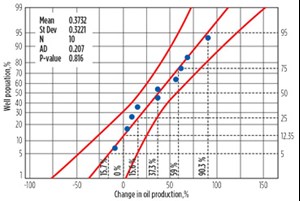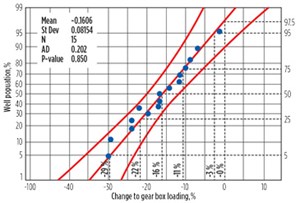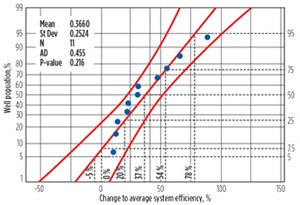Copper alloy coupling reduces rod failures, boosts well efficiency
The deviation and side loading in deep, unconventional wells presents unique challenges for sucker rod pumping, when rods flex during the downstroke of the pumping unit and sucker rod couplings wear into the inner wall of the production tubing. For example, a well pumping at 6 strokes/min. will cycle 8,640 times per day and any given point on the sucker rod string can travel up to 23 miles/day. With so much potential contact between the sucker rod string and production tubing, there is ample opportunity to reduce frictional drag and system loading. Tubing leaks and coupling failures have historically accounted for nearly half of the failures in rod pump wells, with the root cause of these leaks frequently identified as coupling on tubing wear.
COPPER ALLOY COUPLING
A standard spray metal coupling is abrasive to steel production tubing because of its hard-nickel coating. While standard “T” couplings are not coated, nor as hard as spray metal couplings, tubing wear occurs by a steel-on-steel galling mechanism. The T couplings also are more susceptible to corrosion. To alleviate these effects and associated tubing wear, Materion developed a new low-friction, high-strength copper alloy. The ToughMet coupling is made of highly durable spinodal bronze composed of copper, nickel and tin, Fig. 1. The specialized metallurgical composition is naturally anti-galling to steel production tubing. It features high-impact strength, offers improved corrosion resistance and can reduce overall friction on sucker rod strings.
Reducing workover frequency. The new sucker rod couplings were successfully qualified initially in deviated wells with higher-than-average rates of failure. Hess Corp., one of the largest producers in the Bakken, more than tripled its mean time between failures after introducing the couplings to deviated sections of their wells. The company went on to include the couplings in its standard production practice.
Permian basin. Discovery Natural Resources LLC operates more than 1,000 wells in the Permian basin. In some of their extremely deviated wells, rod-on-tubing wear was causing failures every 60 to 90 days. After introducing the copper alloy couplings, the company reported one well running for more than 385 days without failure. Clearly, both operators were able to significantly reduce workovers and effectively improve production efficiencies by utilizing a sucker rod coupling that actively mitigates coupling-on-tubing wear.
ADDITIONAL EFFICIENCY GAINS
In addition to reducing workover costs in deviated wells, there is a wide range of unanticipated benefits of using the new couplings. Identifying improvements in well performance, in addition to reduced tubing failures, was of interest to eight separate operators. Between these different companies, 11 wells are running entire sucker rod strings of ToughMet couplings to investigate and quantify benefits observed by reducing frictional drag in the well. After analyzing their data, the following observations and predictions were made on wells modified to run entire sucker rod strings of the new couplings, where no other design alterations are made:
- 88% of wells experienced an increase in oil production.
- 93% of wells experienced increased downhole stroke.
Downhole stroke is usually much shorter than the stroke length measured at the surface, because rods stretch, contract and deflect. Lowering frictional drag on the sucker rod string allows it to travel more smoothly and with more velocity, translating into greater downhole stroke. Capturing more pump stroke improves compression and allows the well to operate at maximum capacity.
- 87% of wells experienced decreased fluid level above the pump. Decreasing the fluid level is desirable and indicates efficient sucker rod pumping.
- 81% of wells experienced improved pump fillage. Operation is more efficient if the pump is filled with fluid, which lowers electrical power usage.
- 98% of wells experienced gearbox load reduction. Loading on the gearbox is related directly to power requirements necessary to operate a well on rod pump. The gearbox drives the polished rod and provides the torque to rotate the counterweights.
- 95% of wells experienced peak polished rod load reduction. The polished rod holds the entire weight of the sucker rod string below, the weight of the fluid and the added inertial effects as the unit reciprocates. Frictional drag on the sucker rod string increases the load on the polished rod.
- 93% of wells experienced improved system efficiency. Higher system efficiency indicates the well is using less power for more fluid production, and the costs of operation are directly related to this metric.
The data support the hypothesis that the new copper alloy couplings not only reduce tubing wear, but also minimize frictional drag on the sucker rod string. When the sucker rod string can travel more smoothly, wells are able to capture lost downhole stroke and return more efficient fluid production. The couplings also may extend the life of surface equipment and sucker rods, as indicated by smoother pump cards and reduced loads on the gearbox and polished rod. Minimizing frictional drag will likely improve a well’s operating efficiency and deliver associated power savings.
The following case studies detail observations made to improvements in overall efficiency when running entire sucker rod strings of copper alloy couplings.
Case study 1. A Permian basin operator (B), installed 126 couplings in Well 1 during August 2017. Through April 2018, the well experienced overall improved oil production and downhole stroke, while pump fillage stayed static before, and after, coupling installation. Oil production increased an average 35 bpd to 145 bpd, compared to 110 bpd with spray metal couplings. Likewise, downhole stroke length increased by an average of 49 in. to 175 in., compared to 126 in. with spray metal couplings. Loads on the surface equipment also reduced significantly. Gearbox loading was designed to run at 76.5% of its suggested maximum load and averaged 74.6% with the spray metal couplings. After the new couplings were installed, the average gearbox load averaged 63%, which was 12% lower than the spray metal average or 14% below the designed target. Average peak polished rod load decreased by over 8,500 lb, a 27% improvement. This well continues to run the couplings, but failed after 8.3 months in May 2018, due to a rod part. After 2,560,320 cycles, the couplings showed minimal wear, and the serial numbers on the faces were still visible. All of the couplings were reinstalled.
Case study 2. A Permian operator (B) installed an entire sucker rod string, consisting of 186 couplings, into horizontal Well 2 during August 2017. This well ran on rod pump, with both spray metal and T couplings, prior to installing the new-style copper alloy couplings.
Historically, it had failed every 6 to 10 months, due to a tubing leak or rod failure. During workover, the same 1¾-in. pump was rebuilt and reinstalled and fiberglass rods, tubing rotators and rod rotators and guides were maintained. About 50% of the L80 production tubing was also replaced during the workover. The pump was set in the curve at 6,656 ft and side loads average 240 lb. The designed stroke length was 130 in., and the well is running at seven strokes per min. on a variable speed drive. After the new couplings were installed, this well has been running for more than a year without incident.
Well efficiency improvements. During the first six months of operating with the new couplings, oil production averaged 130.5 bpd, compared to 110 bpd prior. When Well 2 was running with spray metal and T couplings, the downhole stroke length was 132 in. versus a 130 in. design. After the new full string of couplings was installed, the well’s downhole stroke recorded between 150 in. and 155 in., gaining an additional 18 in. to 23 in. Pump fillage ran between 92% and 99.9%, compared to 90% before. Likewise, loads on the well’s gearbox, as a percentage of its designed max load, changed from 84% down to 59%-64%, suggesting possible decreased power usage and potential extended gearbox life. Lastly, the peak polished rod load averaged more than 3,000 lb below the historical average.
In April 2018, the operator indicated that the well’s fluid levels were rising because of fracing nearby, therefore data obtained during this time period have not been used to evaluate the performance of the well.
Case study 3. In January 2018, a different West Texas operator (C), installed an entire sucker rod string consisting of 456 copper alloy couplings in an 11,411-ft Permian vertical Well 3. This is a lower-producing well that previously ran spray metal and T couplings. Historically, its failure frequency was an average 119 days, due to various failure modes. Upon workover, the same 1¼-in. pump was reinstalled, and no tubing rotators, rod rotators, or rod guides were implemented to maintain the same well design.
Well efficiency improvements. After a month of run time, reduced friction and loading data were observed alongside increased production, effective net stroke length and pump fillage. The operator noted the following comparisons between the well’s prior performance with spray metal and T couplings and the current performance with ToughMet couplings:
- Oil production increased from 19 bpd to 22 bpd (16%).
- Gearbox loading declined from 87% to 77%.
- Pump stroke improved from 70 in. to 77 in. (10%).
- Pump fillage increased from 80% to 100%.
- Pump friction lessened from 987 lb to 776 lb (21% decrease).
- Pump volume efficiency increased from 55% to 64%.
- Structural unit loading was 2% lower with copper alloy couplings.
- Maximum rod loading was 4% lower with copper alloy couplings.
After two months of run time, the variable frequency drive was removed and replaced with a pump off controller, because the well started to fight gas interference. Now, the well shuts down and idles whenever pump fillage falls below 60%, to allow the wellbore to fill.
After three months of run time, the operator reported that oil production averaged 19 bpd, which is equal to the historical production rate. However, because the well is now operating just 14.6 hr/day, compared to 24 hr/day with the previous design, fluid production cannot be validly compared. Despite this, other benefits were measured:
- Downhole stroke improved even further to 80-85 in. from 70 in. Similar wells in the field were only capturing a 70-75 in. pump stroke.
- Pump fillage was 100% when the well was not affected by gas interference.
- Pump volume efficiency improved to 76%, compared to 55% before.
- Structural unit loading decreased to 85%, compared to 90% before.
- Gearbox loading increased slightly to 81% but was still below pre-copper alloy averages.
- Maximum rod loading decreased to 97%, compared to 114% before.
In April 2018, Well 3 failed due to a broken rod likely caused by paraffin build up. During workover, the couplings showed no wear and were reinstalled. Performance updates will be gathered and averaged over a longer period, as the well continues to run.

Case study 4. In February 2018, another Permian operator (D) installed 286 copper alloy couplings in a 9,200-ft horizontal well. Prior to new coupling installation, Well 4 was operating at 6 SPM on a variable speed drive with spray metal couplings, fiberglass and steel rods and L80 production tubing. This well did not use rod rotators or rod guides. The operator noted that this well fights gas interference and experiences rod buckling in the bottom section of the sucker rod string. To help alleviate gas interference issues, Well 4 is designed to shut off when pump fillage falls below 70%.
Historically, the daily well run time recorded between 20-45%, pump fillage was 81-85% and oil production was 26 bpd. Gas averaged 35 Mscf per day and water averaged 25 bpd. Upon workover, 17 spray metal couplings could not be broken out. However, no other design changes were made to the well, when the new-style couplings were implemented.
Well efficiency improvements. After 2½ months of operation, the operator was surprised to see daily run time double to 60-80% for Well 4. The run time/day increased with the copper alloy couplings, because typical pump fillage was 99.5% and thus remained above the 70% trigger point for shutting the well off more often. The operator suggests that the low-friction couplings have helped to alleviate the buckling in the bottom section of the rod string, allowing for improved compression in the pump, better plunger movement, greater pump fillage and a faster recovery rate. The oil production rate increased 15% to 30 bpd. Gas and water averaged 49 Mcfd and 23 bpd, respectively. The operator noted that Well 4 had not produced 30 bpd since October 2017.

Case study summary. The early results from these field trials show that changing out standard couplings to copper alloy couplings has a positive impact on well performance. The statistics suggest that the new couplings have increased or accelerated the oil production rate 21% on average in these wells. The statistics also confirm the hypothesis that the copper alloy couplings allow wells to capture extradownhole stroke length, increase pump fillage, decrease fluid levels, minimize gearbox wear and alleviate loads on the sucker rod string.
Three probability charts express the likelihood that a well will experience improved performance metrics when installing the new copper alloy couplings, Figs. 2, 3 and 4. This summary of field data enables operators to graphically visualize the effects of reducing friction in their wells and the probability that they will capture the documented benefits of the new couplings.
Although this study reports on the initial findings of field trials that targeted well optimization by using the new couplings, statistical analysis based on a normal distribution model suggests that 93% of wells will experience improved system efficiencies. The probabilities of increasing revenue, while simultaneously reducing cash OPEX and CAPEX, eclipse the minor marginal cost of adopting this technology.

CONCLUSION
To date, 28 operators have installed ToughMet couplings in more than 900 wells in multiple shale fields, including the Bakken and Permian basin. The case studies demonstrate that, in addition to reducing failure rates and avoiding costly workovers, the couplings have a measurable effect on a well’s performance. Each well is operating more efficiently with improved sucker rod string movement, greater downhole stroke, increased pump fillage and accelerated fluid production. In addition, simply switching coupling materials has resulted in decreased loads on the gearbox and polished rod, which suggests that surface equipment life can also be extended.
Performance step-change. Switching sucker rod couplings from standard T or spray metal to the copper alloy couplings achieved the following (on average):
- Oil production increased 21%.
- Downhole stroke increased 23%.
- Pump fillage increased 9%.
- Peak polished rod load decreased 16%.
- Decreased alternating stress on the polished rod by 16%.
- Gearbox loading decreased 16%.
- Fluid level above the pump reduced 28%.
- System efficiency increased 37%.

ACKNOWLEDGEMENT
The authors want to thank the operators who are participating in this project. From a business perspective, having operator derived field data from which to draw risk-adjusted financial expectations is essential.



